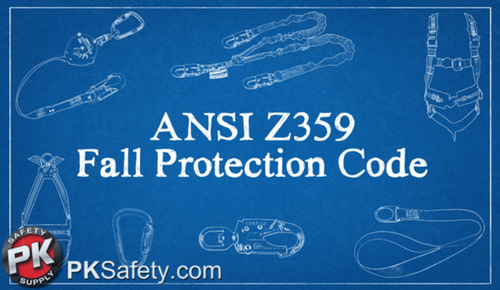What is ANSI Z359 and How Does it Affect Employers?
The American National Standards Institute (ANSI) doesn't make the laws, but it does influence the standards adopted by the Occupational Safety and Health Administration (OSHA) which is tasked with enforcing safety and health legislation. ANSI fall safety standards such as the ANSI Z359 Fall Protection Code are developed by a consensus of experts in government, private industry, and related organizations. But they're not the law, so why do so many people follow their directives?
ANSI Z359 addresses the capacity and measurable safety information for equipment being developed for fall protection in general industry and non-construction job sites. Shock-absorbing lanyards, self-retracting lifelines, other fall protection, anchorage connectors, and a range of fall arrest devices all fall under the umbrella of ANSI Z359. It's important to note that the construction industry has a separate set of standards (ANSI A10.32) which more closely mirrors the OSHA fall safety guidelines.
Industry experts involved with ANSI take a look at the accident and incident reports companies are required to keep for OSHA compliance and use the information to make recommendations for greater work safety. Fall protection is an area which has seen major development and improvement over the past decade. And while OSHA provides fall safety standards that are comprehensive, the ANSI standards typically go farther by requiring, for example, a further reduction in fall impact force to be allowed to act upon a a worker involved in a fall, and greater gate strength for snap hooks and other attachments.
The answer to why businesses choose to follow ANSI standards over the OSHA regulations is largely the threat of litigation. Companies don't want to be accused after an accident of not supplying employees with safety equipment that meets the highest standards. Although the ANSI standards hold the production of fall safety equipment to more stringent requirements than OSHA does, many manufacturers are producing equipment that meet both standards. Some companies, such as Miller, are producing self-retracting lifelines (AKA Personal Fall Limiters) in two models - one which meets OSHA standards, and another that meets both OSHA and ANSI Z359. There is usually a small increase in cost for the ANSI-compliant models.
The questions most companies who buy the ANSI models are looking to avoid in court is something to the effect of "Why didn't you offer the safest equipment to your employees when it was only a matter of a few dollars difference." There simply isn't an answer to that question that isn't going to make a company look bad. Certainly the reply that the equipment covers OSHA standards is going to be seen as fairly thin when ANSI-rated equipment is available side-by-side with the OSHA fall protection equipment
Another reason companies should consider buying fall safety equipment that meets the ANSI Z359 standards is that it may soon become part of the OSHA regulations. Both OSHA and ANSI move slowly. Some would say the pace for both organizations is glacial. But they do move. Some in the industry theorize the reason OSHA has been slow to modify their standards is that the top spots in the OSHA organization are politically appointed. Whatever the case, it seems likely the ANSI Z359 standards, which address this rapidly growing field of fall protection, will eventually make their way into the OSHA regulations.
When this change does happen, any equipment meeting the old OSHA standards will obviously no longer be OSHA compliant. While this might not represent a significant cost for smaller items or equipment that gets replaced fairly regularly, some fall safety equipment is meant to last for a much longer period of time and may be far more costly to replace.
If you are responsible for providing fall protection to general industry or non-construction workers, we believe it is worth the extra expense to provide products that meet the ANSI Z359 Fall Protection Code. You will be providing the best available safety equipment for your employees, as well as insulating the company from legal complications in the event of an accident.
If you have had experiences with OSHA and ANSI standard differences or have questions about the differences between OSHA and ANSI standards, please reach out to us online at pksafety.com or at 800-829-9580 Monday through Friday 7 am - 5 pm PST.
Thanks for reading.
Recent Posts
-
Promoting Safety: National Work Zone Awareness Week is April 15-19, 2024
Each year, the National Work Zone Awareness Week (NWZAW) places the spotlight on the importance o …Apr 11th 2024 -
Understanding 4 Gas Monitors: How They Work & Why They Are Important
In today’s increasingly dynamic industrial landscape, 4 gas monitors have emerged as critical com …Apr 8th 2024 -
April Showers Require Workers to Wear Hi-Vis Safety Rain Gear
While April showers bring May flowers, they also bring challenges, particularly for those working …Apr 1st 2024





